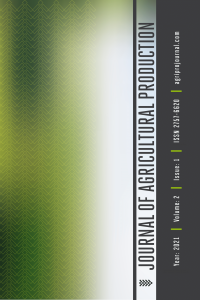Determination of Yield, and Cold Hardiness of Some Triticale (xTriticosecale Wittmack) Genotypes in Eastern Anatolia Region
Abstract
Triticale (xTriticosecale Wittmack) is a grain used in animal feed and is known for its high efficiency, high nutritional quality and resistance to stress factors. Triticale is an alternative plant used for the utilization of marginal areas due to these properties. This study was carried out at three different locations in Erzincan and Muş province and Pasinler districts of Erzurum province. Two candidate line and registered triticale varieties (Umranhanım) and 22 triticale lines in the advanced breeding stage were assessed comparatively in terms of efficiency yield and cold resistance parameters. According to the results of this study, Candidate-2 and Line (1, 6, 8, 11, 15, 17, and 18) genotypes were the prominent genotypes in terms of yield. In addition, low precipitation in May and June caused serious losses in yield. Because this period is the pollination period for grains in the Eastern Anatolia Region. Additional irrigation may be recommended in years when precipitation in this period is insufficient. In addition, it has been concluded that it is important to include cold test studies in breeding programs in regions where winter damage is experienced intensively as well as included in the selections.
References
- Akkaya, A. (1993). Effects of phosphorus rates and application methods on yield and some yield components of winter wheat. Journal of Atatürk University Faculty of Agriculture, 2, 36-50.
- Benbelkacem, A. (1998). Genetic gain over more than two decades of triticale improvement in Algeria. Proceedings of the 4th İnternational Triticale Symposium. Alberta.
- FAOSTAT. (2019). FAO statistics division. Retrieved February 02, 2019, from http://faostat.fao.org
- Karagöz, H., Küçüközdemir, Ü., Dumlu, B., & Yalçın, Z. (2020) Determination of the yield quality and winter durability characteristics of some bread wheat (Triticum aestivum) genotypes in Pasinler and Erzincan locations. Alinteri Journal of Agriculture Sciences, 35(2), 30-36. https://doi.org/10.47059/alinteri/V35I2/AJAS20072 [Crossref]
- Kıral, A. S., & Özcan, H. (1990). Seed, phosphorus and nitrogen application quantities of lancer winter bread wheat in Erzurum dry conditions. Eastern Anatolia Agricultural Research Institute Publication.
- Küçüközdemir, Ü. (2016). Determination of performance and cold tolerance of east Anatolian wheat landraces under Erzurum conditions (Doctoral dissertation, Atatürk University).
- Küçüközdemir, Ü., Dumlu, B., Çakal, Ş., & Özlütürk, A. (2018). Evaluation of some triticale genotypes in terms of yield and some yield and quality components in Erzurum conditions. 2. International Conference on Triticale Biology, Breeding and Production. Poland.
- Küçüközdemir, Ü., Dumlu B., Yalçın, Z., & Karagöz, H. (2019). Determination of yield, quality and winter hardiness characteristics of some triticale (xTriticosecale Wittmack) genotypes in Pasinler and Erzincan locations. Ekin Journal of Crop Breeding and Genetics, 5(2), 74-83.
- Küçüközdemir, Ü., Dumlu, B., Yalçın, Z., & Karagöz, H. (2020). Determination of the yield and cold hardiness characteristics of some bread wheat (Triticum aestivum) genotypes in aqueous conditions. Anatolian Journal of Biology, 1(1), 12-15.
- Kun, M. (1996). Cereals – I (Cool climate cereals). Ankara University Faculty of Agriculture Publication.
- Little, T. M., & Hills, F. J. (1978). Agricultural experimentation design and analysis. John Wiley & Sons Company.
- Maças, B., Countinho, J., & Bagulho, F. (1998). Forage and pasture potential of triticale growing in marginal environments. The case of semi-arid conditions. Proceedings of the 4th İnternational Triticale Symposium. Alberta.
- Mead, R., Curnow, N., & Hasted, A. M. (1994). Statistical methods in agriculture and experimental biology. Chapman & Hall Company.
- Mergoum, M., Ryan, J., Shroyer, J. P., & Monem, M. A. (1992). Potential for adapting triticale in Morocco. Journal of Natural Resources and Life Sciences Education, 21(2), 137-141.
- Müntzing, A. (1989). Triticale results and problems. Advances in Plant Breeding. Supplement to Journal of Plant Breeding. Verlag Paul Parey. Berlin und Hamburg.
- Özcan, H., & Acar, A. (1990). The effects of sowing times of different wheat varieties on grain yield in Erzurum arid conditions. Eastern Anatolia Agricultural Research Institute Publication.
- Özcan, H. (1994). Research on yield, yield components, agronomic characters and quality criteria in some winter bread wheat varieties and lines (Doctoral dissertation, Atatürk University).
- Pfeiffer, W. H. (1994). Triticale: Potential and research status of a manmade cereal crop. Background Material for the Germplasm Improvement Subprogram External Review, Cd. Obregon, Son. Wheat Program. Mexico.
- Royo, C., & Aragay, M. (1998). Spring triticale grown for different end-uses in a Mediterranean-Continental area. Proceeding of the 4th İnternational Triticale Symposium, Alberta.
- TSI. (2019). Turkish Statistical Institute. Retrieved August 07, 2020, from http://www.tuik.gov.tr/PreTablo.do?alt_id=1001
- Yıldız, N., & Bircan, H. (1991). Research and trial methods. Ataturk University Faculty of Agriculture Publication.
Details
| Primary Language | English |
|---|---|
| Subjects | Agricultural Engineering (Other) |
| Journal Section | Research Articles |
| Authors | |
| Publication Date | June 29, 2021 |
| Submission Date | June 20, 2021 |
| Published in Issue | Year 2021 Volume: 2 Issue: 1 |


